Supporting longer term development in crises at the nexus: Lessons from Somalia: Chapter 2
Crisis context
DownloadsA complex and protracted state of crisis
Somalia has one of the most complex and protracted states of crisis anywhere in the world. For the past 30 years Somalia has experienced political instability and frequent conflict, coupled with environmental and economic shocks. These crises have resulted in widespread displacement, food insecurity and high levels of poverty.
Somalia has an intricate societal make up, with complex dynamics governing geographic areas, clans and ethnic groups. Following the collapse of the government led by dictator Siad Barre in 1991, clan-based political coalitions and alliances fought for control throughout the country, with no effective federal government in place. A de facto government in the north declared the formation of an independent Republic of Somaliland in 1991 and continues to seek international recognition of its sovereignty. In 1998, Puntland’s leaders in the north east declared the territory an autonomous state within a federal Somalia. Both regions are in effect self-governing and maintain relative stability in contrast to southern and central Somalia, which remains engulfed in inter-clan political violence. From early 2000, conflict and security dynamics in southern and central Somalia became increasingly complex and internationalised, as Islamist militant groups filled the security vacuum and internationally backed forces conducted counter-insurgency operations.
The international community’s political and security agenda in Somalia has been dominated by two inter-related trends over the last decade and a half. Firstly, the international community supported reconciliation and state-building efforts, aimed at achieving a political settlement among competing political/clan elites and establishing legitimate federal and state governance institutions. Secondly, an African Union (AU) and internationally backed military offensive sought to weaken al-Shabaab and other militant Islamist groups and transfer and consolidate territorial control to legitimate government authorities.
In this context, Somalia took painstaking steps from being a ‘failed’ to a ‘fragile’ state. Substantial progress has been made in establishing federal and state institutions, although political transition is still underway. In 2004, a transitional federal government was established. In 2012, Somalia selected a new president and federal parliament and adopted a provisional constitution, completing the transition to the new FGS. 2017 marked another turning point, as the FGS completed its first political transition since 2012, electing a new parliament and president, through a limited, indirect electoral process. This triggered additional international recognition and support for the FGS. Somalia has since made further progress in establishing and rehabilitating political and government institutions, including the creation of four federal member states in southern Somalia (Jubaland, South West State, Galmudug and Hirshabelle).
Somalia remains, however, an extremely fragile political and security environment. Although al-Shabaab has been substantially weakened, it still retains control in large areas of central and southern Somalia and is capable of carrying out terrorist attacks. Despite progress in building Somalia’s security architecture, the government continues to depend heavily on AU forces to maintain security in strategic areas. In addition, Somalia’s political situation remains fragile despite progress in its political transition; the path towards democratic elections has been challenging and the key issues relating to the relationship between the federal government and federal member states remain unresolved. Furthermore, government infrastructure, institutions and services are still in their infancy, and international agencies continue to provide many basic services.
In the context of ongoing armed conflict and political instability, Somalia has experienced persistent food insecurity, displacement, health and protection crises over the past 30 years. Three-fifths of Somalia’s economy is based on agriculture, with livestock-raising the biggest sector. The dominance of pastoralism and rain-fed agriculture makes the population highly vulnerable to climate shocks and natural disasters. Furthemore, Somalia has high rates of poverty, with 69% of the population living under the international poverty line of US$1.90 a day and an additional 10% living within 20% of it. This means that almost 80% of the population are especially vulnerable to climate-related shocks, conflict and economic disruption.
In December 2019, the UN Office for the Coordination of Humanitarian Affairs (OCHA) estimated that 5.2 million Somalis were in need of humanitarian assistance, of which 63% were children. Up to 2.1 million Somalis were facing severe hunger if humanitarian assistance was not available; food and nutrition deficiencies are especially prevalent in agro-pastoral, marginalised and displaced communities. [1] Inadequate water, sanitation and health services in many areas increase the risks of disease outbreaks, including cholera, diarrhoea and, more recently, Covid-19. Figure 1 shows food insecurity, poverty and displacement by region.
Figure 1: Levels of food insecurity, poverty and displacement by region
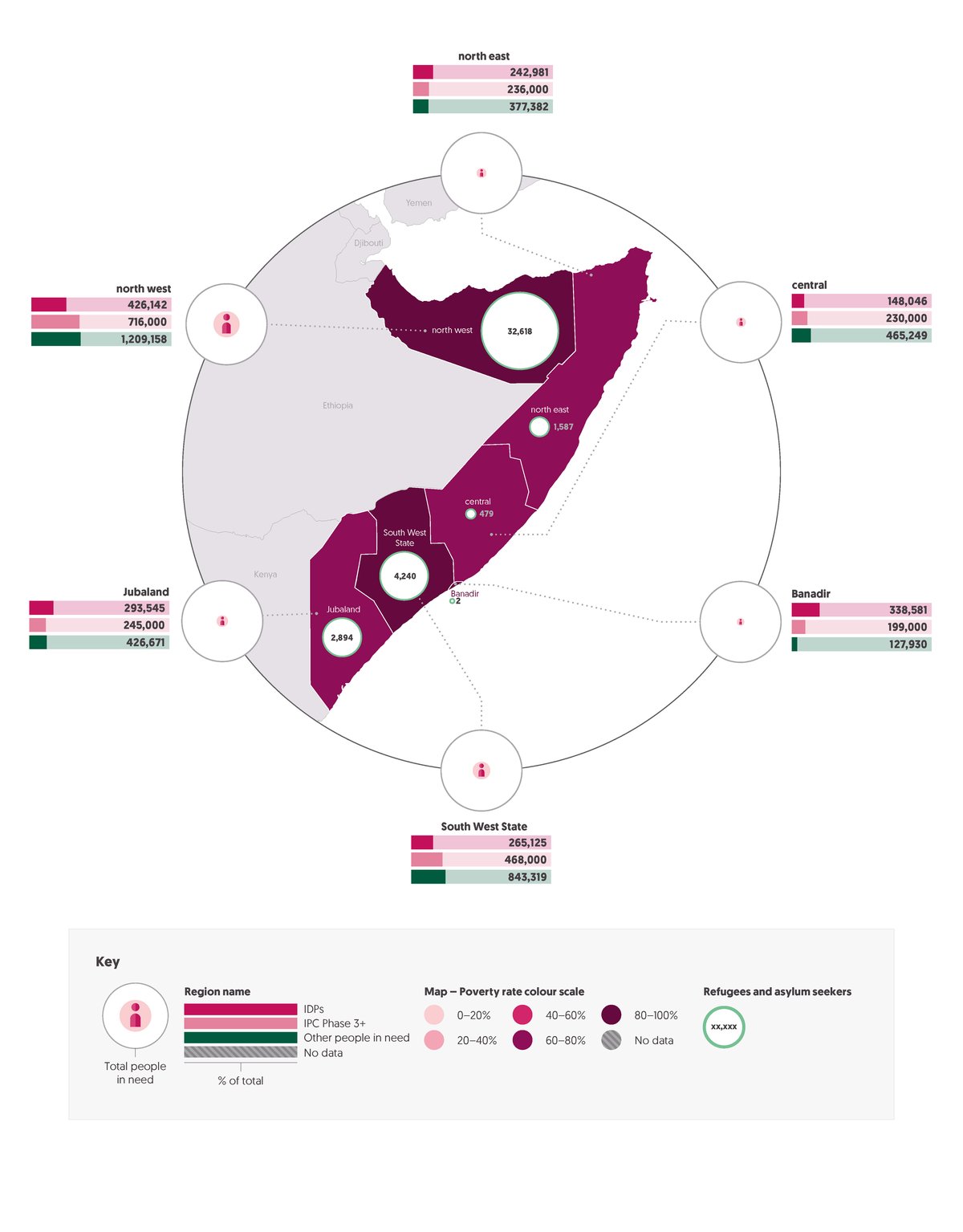
Map showing levels of food insecurity, poverty and displacement by region in Somalia, with the highest number of displaced people in need in the north west region (1.6 million), followed by South West State (1.1 million) and Jubaland (723,111). The highest level of food insecurity was in north west (716,000 people in IPC Phase3+) and in South West State (468,000 people in IPC Phase3+). 90.5% of households in Banadir region were within the poorest 20% of people (P20) in Somalia, as were 84.0% of households in north west.
Source: Development Initiatives based on the UN OCHA 2020 Humanitarian Needs Overview for Somalia (2019), IPC Acute Food Insecurity Classification, Somali High Frequency Survey (2017) and IMF World Economic Outlook (2020).
Notes: Humanitarian Needs Overview data on refugees and asylum-seekers, IDPs and total people in need are as of December 2019. Total displaced people do not include returnees. IPC Phase 3 and above figures are projections for October to December 2019 and include people experiencing acute food and livelihood crisis, humanitarian emergencies or famine and humanitarian catastrophe. 85.5% of people in IDP settlements are within the poorest 20% of people (P20) in Somalia, as are 84.5% of people in nomadic populations. The geographical regions include the following administrative regions: Benadir (Mogadishu), Jubaland (Gebo, Lower Juba, Middle Juba), central (Hiraan, Middle Shabelle, Galgaduud), north east (Bari, Mudug, Nugaal), north west (Awdal, Sanaag, Sool, Togdheer, Woqooyi) and South West State (Bay, Bakool and lower Shabelle). IDP = internally displaced people; IMF = International Monetary Fund; IPC = Integrated Food Security Phase Classification; P20 = people in the poorest 20%; UN OCHA = UN Office for the Coordination of Humanitarian Affairs.
Natural disasters and environmental shocks: droughts, floods and locusts
With an arid and semi-arid climate, Somalia is prone to recurring droughts as well as to flooding during the annual monsoon season, with erratic weather becoming more frequent in recent years. Since 1960, Somalia has experienced 14 droughts, averaging one every four years and causing severe food insecurity. Between 2010 and 2012, 260,000 people died during a famine triggered by severe drought and worsened by conflict between rival political groups. Another prolonged drought occurred in 2016 and 2017, but the intervention of the humanitarian sector is widely credited with preventing a similar famine.
Extreme and erratic weather, including flash floods, have contributed to widespread food insecurity and displacement in recent years. Floods in 2020 have displaced approximately 500,000 people. In late 2019, desert locust swarms spread into Somalia from Yemen across the Red Sea, after heavy rainfall allowed the insects to flourish. The Ministry of Agriculture declared a national emergency in February 2020. The current locust outbreak is the worst to hit the country in 25 years, with swarms causing crop and pasture loss in areas across the country, impacting the livelihoods of nearly 2.6 million people living in 43 districts. [2] Crop loss has contributed to food insecurity, malnutrition and displacement.
The 2017 pre-famine response fostered increasing acknowledgement that humanitarian assistance alone cannot offer a sustainable or cost-effective solution to recurring climatic shocks in Somalia. [3] Rather, there must be a shift towards longer term investment in forecasting and anticipatory action, risk reduction and resilience. At the same time, the recent locust crisis has tested the international community’s ability to respond to major, unanticipated peaks in need. Efforts to tackle the desert locust crisis are focusing on short-term needs such as food security as well as supporting longer term livelihoods.
Multiple forms of armed conflict and insecurity
Somalia is affected by multiple forms of armed political violence and insecurity, including terrorist attacks by Islamist militant groups, counter-insurgency operations, inter-clan political violence, local inter-communal violence, and organised and individual criminal violence.
The state-building process in Somalia has supported a political settlement between Somalia’s clan elites, with power-sharing arrangements ensuring representation in the federal and member state governments. This has substantially reduced large-scale inter-clan violence, driven by elite competition for power and control of resources. However, Somalia’s political balance remains extremely fragile, as is manifested in disputes between the FGS and the federal member states and between rival clans. Somalia is also affected by recurring and localised inter-communal conflict over resources, particularly involving pastoralist groups competing for water.
Although substantially weakened, al-Shabaab retains control of many rural areas in southern Somalia and continues to launch terrorist attacks within Somalia and surrounding countries, including truck bombings in Mogadishu in 2017 and 2019, an attack on a Nairobi hotel in 2019, and hundreds of improvised explosive attacks targeting civilians within Somalia. [4] Other militant groups also challenge state authority and pose a security risk. Abnaa ul-Calipha (Islamic State in Somalia) splintered from al-Shabaab in 2015 and was recognised as an official province by the Islamic State in 2017. Active primarily in Puntland, the Islamic State in Somalia has an estimated 200 to 300 active fighters. While much smaller than al-Shabaab, the group carried out terrorist attacks in Puntland and Mogadishu and engaged in frequent clashes with al-Shabaab.
In 2017 and 2019 the UN Security Council approved the withdrawal of a thousand AU troops as part of a transition of security responsibilities to the FGS, with the intention of Somali forces leading security by 2021. However, US and AU forces continue to support the Somali National Army to combat al-Shabaab and other Islamist militant groups and capture territory controlled by them.
Cooperation between HDP actors is challenging in Somalia given the high levels of fragility and volatility, especially where armed non-state groups are active and there is ongoing armed conflict. Armed groups threaten the legitimacy and capacity of the state and can undermine or render development efforts extremely difficult. The focus on stabilisation in these areas makes it challenging to achieve consensus between humanitarian and other external political, security and development actors because of the imperative to safeguard humanitarian principles.
Large-scale displacement
Around 2.6 million Somalis are displaced internally within Somalia; more than half were displaced following failed rainy seasons in 2016. In 2019, the leading cause of displacement was disasters (mainly flooding), which displaced 479,000 people, followed by conflict and violence, which displaced 188,000 people, largely in the south east of the country where al-Shabaab is most active. The forced eviction of internally displaced people (IDPs) is a significant cause of secondary displacement, with more than 264,000 IDPs evicted during 2019. [5]
IDP settlements are found throughout the country, with the largest concentration around Mogadishu. Many displaced people have been forced to move to urban areas to access humanitarian assistance, driven from other areas by natural disasters and armed conflict between government forces, their allies and non-state armed groups, as well as clan-based violence. [6] These large-scale population movements add pressure to already constrained resources and services in urban areas. IDPs are now among some of the most vulnerable communities in Somalia.
Many Somalis have fled to other countries over recent decades, and the UN High Commissioner for Refugees (UNHCR) estimates that more than 905,000 refugees are outside of Somalia, largely spread between Kenya, Yemen and Ethiopia. [7] Since the launch of a UNHCR-assisted repatriation programme in 2014, over 91,000 Somali refugees have voluntarily repatriated (although this rises to 130,000 when considering spontaneous (non-assisted) returns from Kenya, Yemen and other countries). [8] UNHCR also assists 30,000 refugees and asylum seekers from other countries such as Ethiopia and Yemen.
Somali federal and local governments have made progress developing policies and frameworks to protect IDPs and reach durable solutions for displacement-affected communities. The FGS ratified the Kampala Convention in 2019, affirming the rights of IDPs, and has adopted a national IDP policy. The FGS has also established a cross-government Durable Solutions Secretariat, which includes all ministries and federal institutions and brings together humanitarian and development actors to achieve collective outcomes (covered further in the ‘ Programming approaches ’ chapter). The Durable Solutions Secretariat is making progress on a national durable solutions strategy. At the local level, the Municipality of Mogadishu established the Durable Solutions Unit in the mayor’s office [9] and developed the Mogadishu Durable Solutions Strategy. [10]
A key challenge for the durable solutions agenda is practically applying the HDP nexus, recognising that humanitarian, development, peace and security, and political actors all have a critical role in tackling protracted displacement. [11]
Additional pressure from the Covid-19 pandemic
For Somalia, the Covid-19 pandemic comes together with many existing crises and poses a major challenge to a health system left in disrepair after years of civil war and underinvestment. Somalia ranks 194/195 on the Global Health Security Index, with low numbers of healthcare workers and intensive care beds, and is one of the least prepared countries in the world to detect and report epidemics. [12] The World Health Organization (WHO) has warned that impacts from the Covid-19 pandemic risk reversing recent health gains in Somalia [13] and societal impacts include a worsening of violence against women. [14] The WHO is leading the health response to Covid-19 in Somalia, including supporting FGS national plans, and a UN-wide technical task force has been formed to support the FGS. [15]
Covid-19 restrictions have also limited humanitarian responses to existing crises including floods, diarrhoea and cholera outbreaks, and locusts, exacerbating vulnerability and the needs of crisis-affected populations. The pandemic has also impacted remittances, although despite remittance inflows initially dropping in April 2020 at the outset of Covid-19, recent data shows they have recovered and been stronger than anticipated. [16]
Government policies and domestic financing
Progress in development policy and strategy
NDP9 (2020–2024) [17] was drafted by the Ministry of Planning, Investment and Economic Development (MoPIED), building on NDP8 (2017–2019). NDP8 was the first to be drafted by the Somali government since 1986 and followed the 2013 New Deal Compact for Somalia, which functioned as the country’s development and political roadmap. The New Deal Compact for Somalia arose from the New Deal for Engagement in Fragile States agreed in 2011 at Busan, a global policy agreement where development partners committed to supporting nationally owned and led development plans.
NDP9 was formulated to meet the requirements of an interim Poverty Reduction Strategy Paper to allow Somalia, as a participant of the Heavily Indebted Poor Countries (HIPC) Initiative, to apply for debt relief. The principal objective of NDP9 is poverty reduction, and it has four pillars: inclusive politics, security and rule of law, economic development, and social development. It aims to transform the economy by improving the resilience of the traditional livestock and crop production industries to better meet the growing challenges from climate change, while encouraging growth in the private sector to expedite sustainable growth and employment more widely.
Low domestic revenue and spending
The FGS has a small budget per capita compared with other countries in sub-Saharan Africa – Somalia’s cabinet approved a budget increase for 2020 to US$476.1 million. [18] This is one-sixth the budget of Rwanda, which has a similar population size. As shown in Figure 2, the Federal 2018 budget of US$286.1 million is smaller than that of Somaliland (US$326.3 million), illustrating the fledgling situation of the FGS compared with Somaliland, which has had more established governance for some years.
Figure 2: Somalia federal and state budgets, 2018
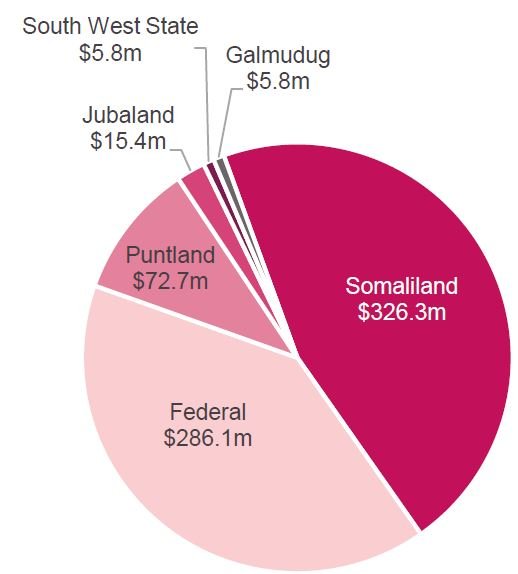
There are six regions shown in the pie chart: Somaliland, Federal, Puntland, Jubaland, South West State and Galmudug. The Somaliland budget is the largest at 46% of the total, followed by Federal at 40% and Puntland at 10% share. The remaining three regions had budgets between 1−2% share in 2018.
Sources: Somalia IMF staff, Somali state governments.
Notes: Data is in US$ current prices. Domestic public resources refer to government revenue, excluding international grants and federal transfers. Figures refer to budget estimates. 2018 is the latest year with available data on state budgets for Somalia. Hirshabelle and the Banadir Regional Administration are missing from the chart as data is not available. IMF = International Monetary Fund.Most tax revenue raised by the FGS comes from Mogadishu, with the reach of the FGS limited beyond the capital. Member state governments collect customs revenue levied at airports, land borders and the maritime ports of Jubaland, Puntland and Somaliland, which are spent by each state for their own purposes.
The FGS faces significant challenges in increasing tax revenue, with no effective domestic tax system, a weak formal economy and fragile revenue-generating sectors. Somalia’s economy is largely informal with little effective regulation, and it is based primarily on the livestock, agriculture, fisheries, communications and energy sectors. The economy also relies on imported goods and services funded by remittances. While accurate data is lacking, most estimates place Somalia’s GDP per capita among the bottom five countries in the world. Its domestic revenue as a share of GDP also remains very low, estimated at 2.8% in 2017. [19] Tax compliance from citizens and corporations is inconsistent, largely owing to the lack of a functioning tax administration system.
Another barrier to raising tax revenue is low public confidence that paying taxes to government will lead to the provision of public services. This is partly due to budget limitations: most of the FGS budget goes to paying civil servant and security staff salaries, with little left over for public services. This highlights the importance of state legitimacy and public trust in ensuring progress in development efforts. With the relative absence of a functioning state for a long period, strengthening the social contract in Somalia is difficult and has largely come second to more pressing issues such as security. [20] As the FGS continues to establish itself, international development actors such as the World Bank are seeking to support state legitimacy through national safety net programmes (covered further in the ‘ Programming approaches ’ chapter).
Figure 3: Sector spending by federal and state governments, 2018

There are six regions shown in the chart: Federal, Somaliland, Jubaland, South West State, Puntland and Galmudug. Federal budget is mostly spent on the administration (52%) and security sectors (36%). Somaliland budget is more evenly split between the security (34%), economic (25%) and administration sectors (23%). More than half of the Jubaland and South West State budgets are spent on the economic sector, at 52% and 56% respectively. Puntland budget is mostly spent on the administration (49%) and security sectors (36%). The Galmudug budget is more evenly split between the security (39%), administration (33%) and economic sectors (23%).
Source: Somali Federal and State Budgets for 2018.
Notes: Data is in US$ current prices. Domestic public resources refer to government revenue, excluding international grants and federal transfers. Figures refer to budget estimates. 2018 is the latest year with available data on state budgets for Somalia. Hirshabelle and Banadir Regional Administration are missing from the chart as data is not available.
FGS spending is dominated by administrative and recurring costs, such as public sector salaries (with administration costs comprising 52% of spending in 2018) and operational costs (where security costs comprised 36% of spending in 2018), with little left for the social sector (only 4.1% in 2018) (Figure 3). State governments allocated 10% or less of their budgets to social sectors in 2018, apart from Somaliland (18%), which is likely to reflect its comparatively larger budget and established government structures. The capacity for state governments to address vulnerability and support longer term recovery, development and livelihoods is thus minimal. This points to the pressing need for ongoing support from development partners to strengthen the institutional capacity of the FGS and state governments so that government-led social services can be scaled up.
International financing landscape
Somalia receives large volumes of international aid and remittances. For much of the past two decades, donors and international actors have focused on responding to humanitarian crises and state-building and stabilisation. In recent years, the establishment of a nascent federal government and a desire to break out of cycles of humanitarian crises has seen a will among donors to scale up longer term, resilience-focused development programming.
Remittances is the largest category of external finance
The Somali diaspora numbers over 1 million people worldwide. Alongside official development assistance (ODA) and security assistance, remittances are the largest category of external financial support to Somalia. The estimated volume of remittances from Somalis abroad was US$1.5 billion in 2018 and 2019, accounting for one-third of GDP. [21] This is equivalent to the total ODA to Somalia in 2018 (US$1.5 billion) and double the humanitarian assistance (US$713.6 million). An estimated 40% of Somali people receive remittances, but they are not equally distributed; recipients are concentrated in clans, lineages and extended families concentrated in Somaliland and Puntland.
Among the households that receive remittances, the monthly average income from remittances is US$229. [22] As well as improving purchasing power to meet basic needs, access to remittances improves access to credit, with the debt–credit relationship important for the economy and society in the absence of a formal banking system. [23]
Only a minority of people receive remittances from more than one source, so this source of income is vulnerable to changes in the circumstances of the sender. Despite remittance inflows initially dropping in April 2020 at the outset of Covid-19, recent data shows remittance inflows have recovered and been stronger than anticipated. [24]
The country is on a path to debt relief
After more than 30 years of being ineligible to receive financial assistance from international financial institutions (IFIs), in 2020 Somalia took critical steps towards normalising relations and resuming funding. In March 2020, Somalia achieved the milestone of reaching the ‘decision point’ of the HIPC Initiative, restoring access to regular concessional financing and bringing the country closer to debt relief. Once Somalia reaches the HIPC Initiative ‘completion point’, its external debt is expected to fall from US$5.2 billion (as at the end of 2018) to US$557 million (in net present value terms). This will enable Somalia to fully re-engage with IFIs, including the World Bank’s IDA, which provides funding to the poorest countries. Somalia has been able to access new IDA funds for crisis response and resilience projects, including the Somalia Crisis Recovery Project and Shock Responsive Safety Net for Locust Response programme (see the ‘ Programming approaches ’ chapter). Since March 2020, the World Bank has provided nearly US$400 million in financing to Somalia. [25]
The normalisation of relations with IFIs also signals a transition towards channelling funding through the FGS single treasury account and paves the way for Somalia to access larger scale development finance, although there is still caution among donors and UN agencies about using government systems for financing and providing direct budgetary support.
Official development assistance is increasing
ODA received by Somalia has more than doubled since 2009, increasing from US$628.2 million to US$1.5 billion in 2018, peaking at US$1.7 billion in 2017 in response to a surge of drought relief (Figure 4).
Given the absence of government structures and reliance on humanitarian structures for service delivery, humanitarian assistance has been the largest component of ODA, representing 51% of total ODA from 2009 to 2018; in 2018, 47% of ODA was humanitarian assistance. Fluctuations in humanitarian assistance from 72% in 2011 to 32% in 2015 illustrate Somalia’s vulnerability to shocks; a peak in 2017 was in response to drought and instrumental in averting famine. [26] There was also a gradual increase in developmental ODA between 2009 and 2018, with a peak in 2015 (US$773.9 million) due to increased spending on social infrastructure and services aligned with the New Deal Compact for Somalia. Growing international support for the FGS and momentum on the durable solutions agenda in recent years may sustain this trend towards higher volumes of developmental ODA. While OECD Creditor Reporting System (CRS) data is not yet available for years after 2018, 2019 mapping by MoPIED [27] shows a steep decline in total ODA to Somalia in 2019, from US$2.2 billion in 2018 to US$1.9 billion in 2019, followed by a further predicted decline to a total of US$0.9 million in 2020.
Figure 4: ODA breakdown by purpose code, 2009–2018
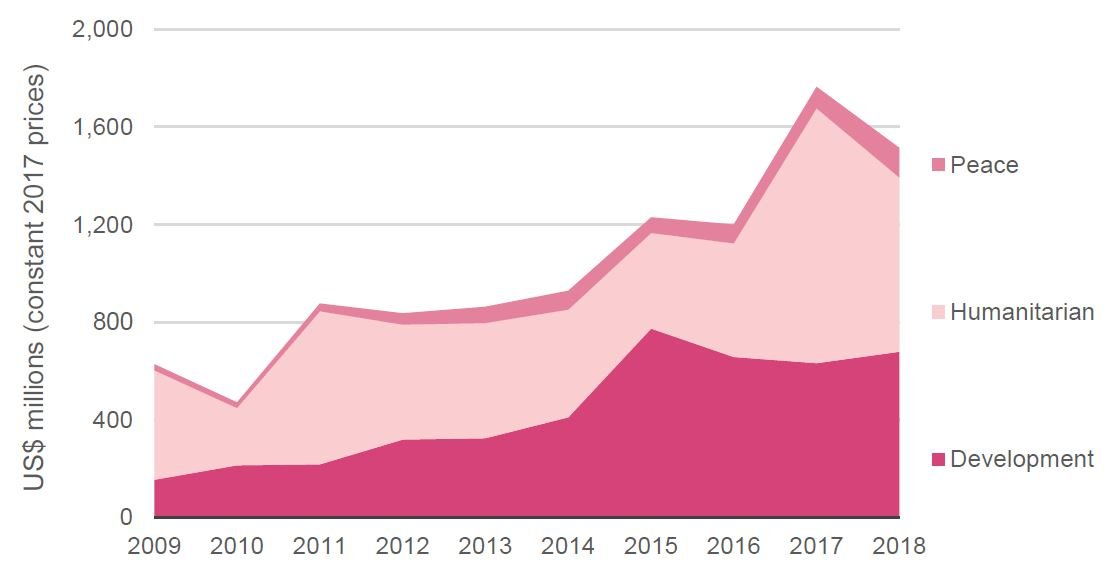
Official development assistance (ODA) received by Somalia has increased from US$628.2 million in 2009 to US$1.51 billion in 2018, peaking at US$1.76 billion in 2017. Humanitarian assistance represented the largest component of ODA with a 71% share in 2009, reducing to a 47% share in 2018. ODA increased gradually between 2009−2018, with a peak in 2015 (a 63% share, or US$773.9 million). Peace ODA fluctuated between a 4% share in 2009 and 8% in 2018.
Source: Development Initiatives based on OECD DAC Creditor Reporting System (CRS).
Notes: Data is in US$ millions, constant 2017 prices. ODA is from DAC, non-DAC and multilateral donors. ‘Humanitarian’ includes CRS purpose codes for emergency food assistance; immediate post-emergency reconstruction and rehabilitation; material relief assistance and services; multi-hazard response preparedness; and relief co-ordination and support services. ‘Peace’ includes CRS purpose codes for civilian peacebuilding, conflict prevention and resolution, and participation in international peacekeeping operations. ‘Development’ includes all other purpose codes under total ODA. CRS = Creditor Reporting System; ODA = official development assistance.
Figure 5: ODA breakdown by sector, 2009–2018
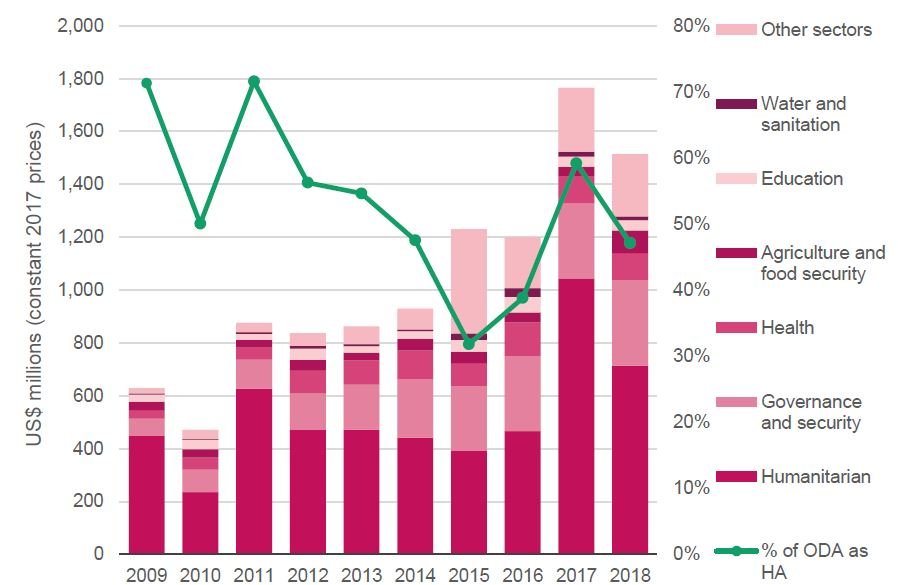
While humanitarian assistance represented the largest component of official development assistance (ODA) between 2009 and 2018, ODA to other sectors varied. The volume of ODA to governance and security gradually increased, fluctuating between a 10% share in 2009, rising to 24% in 2016 before dropping sharply to 16% in 2017, then rising again to 21% in 2018. ODA to health; agriculture and food security; education; and water and sanitation represented less than 10% of total ODA, with % shares in 2018 of 7%, 6%, 2% and 1%, respectively.
Source: Development Initiatives based on OECD DAC Creditor Reporting System (CRS).
Notes: Data is in US$ millions, constant 2017 prices. ODA is from DAC, non-DAC and multilateral donors. CRS = Creditor Reporting System.
While humanitarian assistance was consistently the largest component of ODA between 2009 and 2018, ODA to other sectors varied. The volume of ODA to governance and security gradually increased, although it fluctuated as a proportion of overall ODA, rising to 23.7% in 2016 before dropping sharply to 16.1% in 2017, then rising again to 21.4% in 2018 (Figure 5).
Figure 6: The five donors that gave the most ODA to Somalia, 2009−2018
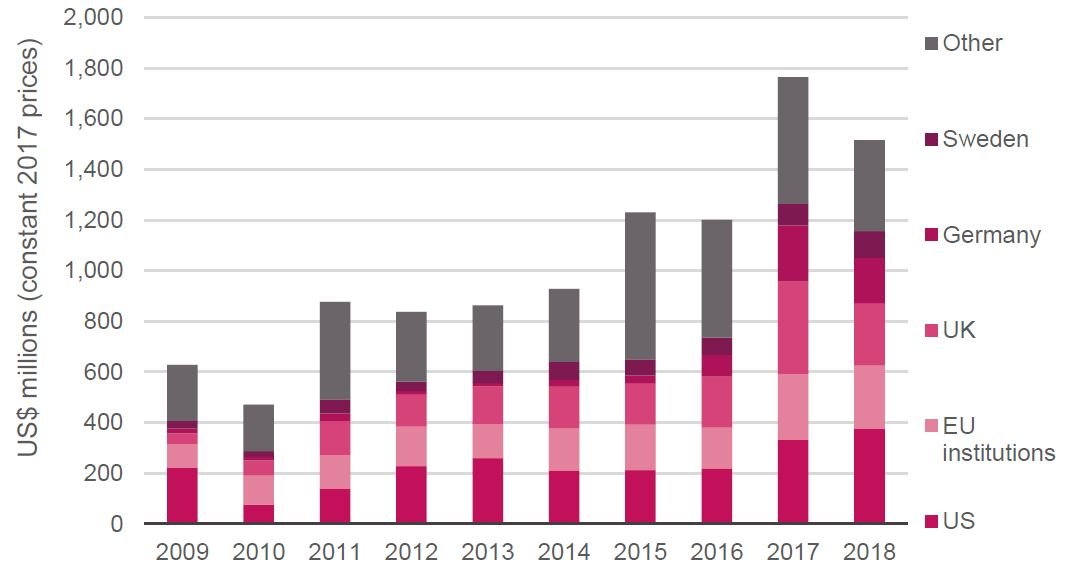
The US was the largest donor to Somalia, providing US$2.3 billion between 2009-2018, followed by EU institutions (US$1.7 billion) and the UK (US$1.7 billion). Other donors shown in the chart are Germany (US$628.9 million) and Sweden (US$585.1 million). In 2018, ODA from the US represented a quarter (25%) of the total, followed by EU institutions (17%), the UK (16%), Germany (12%) and Sweden (7%).
Source: Development Initiatives based on OECD DAC Creditor Reporting System (CRS).
Notes: US$ millions, constant 2017 prices. ODA is from DAC, non-DAC and multilateral donors. CRS = Creditor Reporting System.
Between 2009 and 2018, the US was the donor that gave the most ODA to Somalia, providing US$2.3 billion over the 10 year period, followed by EU institutions (US$1.7 billion) and the UK (US$1.7 billion). Other donors providing large amounts of ODA were Germany (US$628.9 million), Sweden (US$585.1 million), Norway (US$448.9 million) and Turkey (US$430.3 million) (Figure 6).
Donors outside of the DAC membership have a growing presence in Somalia, with Turkey, the United Arab Emirates and Saudi Arabia among the 30 donors giving most ODA to Somalia between 2009 and 2018. The FGS received foreign grants (including from Saudi Arabia), which it managed outside of the treasury and financial management information system, and the full amount of these grants is unknown. [28] Aid from these non-traditional donors differs from traditional Western donors, with a focus on bilateral support to state authorities or infrastructure projects, and there is less distinction between relief, development and post-conflict recovery. [29]
In recent years, the FGS, Somaliland and Puntland received the greatest amounts of ODA (US$219.2 million, US$224.0 million and US$194.4 million in 2019, respectively) (Figure 7). The states experiencing active conflict by comparison received a much lower proportion, for example Galmudug and Hirshabelle received US$78.2 million and US$95.2 million in 2019, respectively. This probably reflects challenges related to access and the weakness of government structures. Volumes of budgeted funding to the FGS more than doubled in 2020, probably because of new IDA funding.
Figure 7: ODA received by federal and state governments, 2017−2020
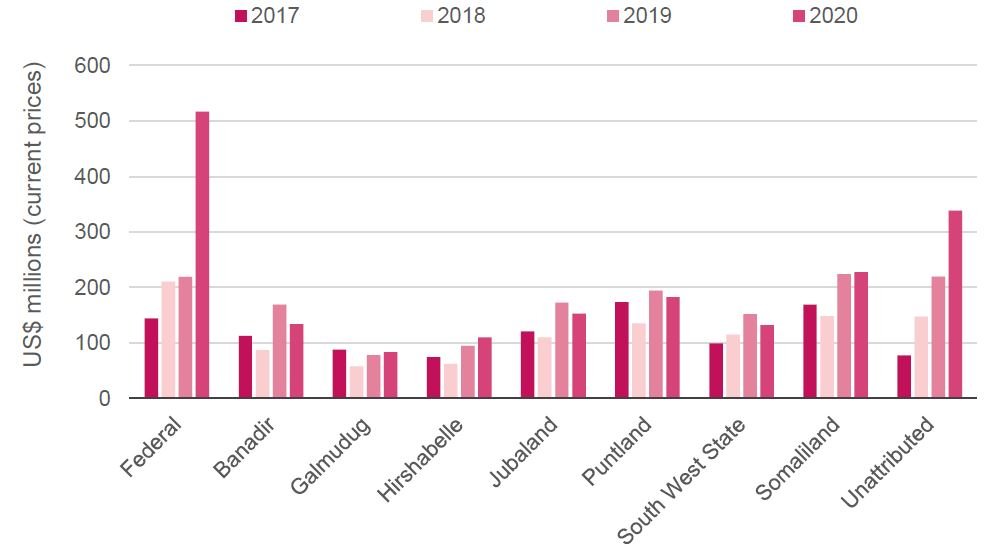
Federal, Somaliland and Puntland received the largest amounts of official development assistance to Somalia in 2019 at US$219.2 million, US$224.0 million and US$194.4 million respectively. The remaining states received lower shares: Puntland (US$194.4 million), Jubaland (US$172.5 million), Banadir (US$169.0 million), South West State (US$151.8 million), Hirshabelle (US$95.2 million) and Galmudug (US$78.2 million).
Source: Somalia Aid Information Management System.
Notes: Data is in US$ current prices. ODA with missing regional information is categorised as Unattributed. 2020 values include budgeted amounts.
Peace and security assistance falls outside of ODA
According to the most recent estimates in 2017, international partners spend an estimated $1.5 billion per year on peacekeeping, counter-insurgency and support to the Somali security sector, which falls outside the scope of ODA. [30] This includes US$750−850 million per year to the AU Mission in Somalia joint military operations, comprising financing provided directly by the EU and logistical support provided through the UN Support Office in Somalia. This figure excludes international maritime anti-piracy measures. The US is the largest contributor of security assistance, providing US$400 million per year in ‘Somalia-focused’ aid in the Horn of Africa, and the EU, Turkey, United Arab Emirates and the UK are the next largest contributors. [31]
Pooled funds and crisis-financing mechanisms are in use
From 2014, a number of multi-partner trust funds were established to deliver FGS national development priorities set out in national development plans within the coordination framework of the Somalia Development and Reconstruction Facility (SDRF). These include the UN Multi-Partner Trust Fund, the World Bank Multi-Partner Fund (MPF), and the AfDB’s Somali Infrastructure Fund (SIF), which support government-led institution building, service delivery and infrastructure development. [32] Initiated in 2012, the Somalia Stability Fund is a multi-donor financing mechanism that aims to enhance local governance and reduce political and communal conflict, designed to respond flexibility and rapidly to needs and opportunities. Global multilateral funds also play a key role, such as the UN Peacebuilding Fund (see Appendix 2 for an overview of financing mechanisms).
Financing the Covid-19 response
There has been significant financing for the response to the Covid-19 pandemic in Somalia, with more than US$60.1 million of Covid-19 disbursements reported to IATI in 2020 (Figure 8). Humanitarian assistance has comprised the majority of ODA to Covid-19; it accounted for 53% of assistance reported to IATI in 2020, and 95% of disbursements reported in Quarter 4 of 2020. This may reflect the predominance of humanitarian structures for service delivery in Somalia as the favoured channel for reaching communities quickly, but it may also be due to differences in the reporting practices of organisations publishing data to IATI. The volume of developmental ODA for the Covid-19 response increased in 2020, from US$2.9 million in Quarter 1 to US$20.6 million in Quarter 3 (mainly representing transactions reported by the World Bank to the Somalia Crisis Recovery Project). [33] A significant amount of development funding used for the Covid-19 response was repurposed from existing donor allocations, following a scale up of the Somalia Covid-19 humanitarian response plan to US$784.3 million in August 2020. [34]
Figure 8: Total disbursements to Covid-19 as humanitarian and development assistance, 2020 by quarter
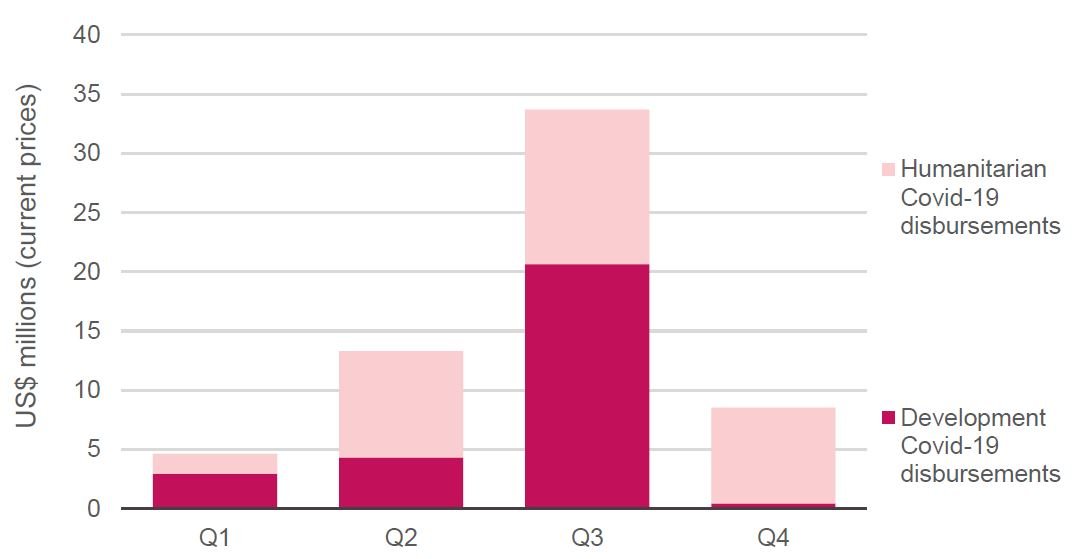
Disbursements to Covid-19 increased from US$4.6 million in Q1, to US$13.2 million in Q2, then spiked in Q3 to US$ 33.6 million, and dropped in Q4 of US$8.5 million. The share of humanitarian Covid-19 disbursements fluctuated between 36% in Q1, to 39% in Q3 and 95% in Q4.
Source: Development Initiatives based on International Aid Transparency Initiative (IATI) data.
Notes: Data is in US$ current prices. Data grouped by quarters, with Q1 summing transactions from January−March; Q2 from April−June; Q3 from July−September; and Q4 from October−December 2020. Activities are marked as Covid-19 related according to the IATI Covid-19 publishing guidance. Humanitarian disbursements include transactions marked with the IATI Humanitarian Flag, with all other transactions included under Development disbursements. Data last updated on 06/01/2020. Data extracted from the Covid-19 tracking prototype available at: https://covid19.humportal.org/
Notes
-
1
UN Office for the Coordination of Humanitarian Affairs (OCHA), 2019. Humanitarian Needs Overview: Somalia. Available at: www.reliefweb.int/report/somalia/2020-somalia-humanitarian-needs-overviewReturn to source text
-
2
World Bank, World Bank approves $40 million emergency financing to support Somalia’s desert locust response, [press release], 29 June 2020, www.worldbank.org/en/news/press-release/2020/06/29/world-bank-approves-40-million-emergency-financing-to-support-somalias-desert-locust-response (accessed 11 December 2020)Return to source text
-
3
Humanitarian Policy Group, Overseas Development Institute (ODI), 2019. The 2017 pre-famine response in Somalia: Progress on reform? Available at: www.odi.org/publications/11276-2017-pre-famine-response-somalia-progress-reformReturn to source text
-
4
UN Security Council, 2019. Report of the Panel of Experts on Somalia (S/2019/858). Available at: www.un.org/securitycouncil/sanctions/751/work-and-mandate/reportsReturn to source text
-
5
Internal Displacement Monitoring Centre. Somalia. Available at: www.internal-displacement.org/countries/somalia (accessed 18 December 2020)Return to source text